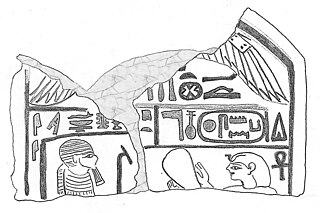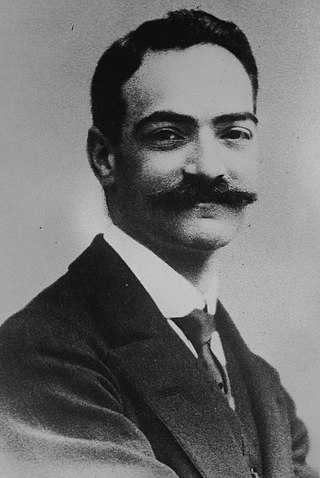Related Research Articles

Tanis or San al-Hagar is the Greek name for ancient Egyptian ḏꜥn.t, an important archaeological site in the northeastern Nile Delta of Egypt, and the location of a city of the same name. It is located on the Tanitic branch of the Nile, which has long since silted up.

Amenemhat III, also known as Amenemhet III, was a pharaoh of ancient Egypt and the sixth king of the Twelfth Dynasty of the Middle Kingdom. He was elevated to throne as co-regent by his father Senusret III, with whom he shared the throne as the active king for twenty years. During his reign, Egypt attained its cultural and economic zenith of the Middle Kingdom.

Pepi I Meryre was an ancient Egyptian pharaoh, third king of the Sixth Dynasty of Egypt, who ruled for over 40 years at the turn of the 24th and 23rd centuries BC, toward the end of the Old Kingdom period. He was the son of Teti, the founder of the dynasty, and ascended the throne only after the brief intervening reign of the shadowy Userkare. His mother was Iput, who may have been a daughter of Unas, the final ruler of the preceding Fifth Dynasty. Pepi I, who had at least six consorts, was succeeded by his son Merenre Nemtyemsaf I, with whom he may have shared power in a coregency at the very end of his reign. Pepi II Neferkare, who might also have been Pepi I's son, succeeded Merenre.

Jebel Barkal or Gebel Barkal is a mesa or large rock outcrop located 400 km north of Khartoum, next to Karima in Northern State in Sudan, on the Nile River, in the region that is sometimes called Nubia. The jebel is 104 m tall, has a flat top, and came to have religious significance for both ancient Kush and ancient Egyptian occupiers. In 2003, the mountain, together with the extensive archaeological site at its base, were named as the center of a World Heritage Site by UNESCO. The Jebel Barkal area houses the Jebel Barkal Museum.
Qift is a city in the Qena Governorate of Egypt about 43 km (27 mi) north of Luxor, situated a little south of latitude 26° north, on the east bank of the Nile. In ancient times its proximity to the Red Sea made it an important trading emporium between India, Punt, Arabia Felix and the North. It was important for nearby gold and quartzite mines in the Eastern Desert, and as a starting point for expeditions to Punt.

Semenkare Nebnuni is a poorly attested pharaoh of the early 13th Dynasty during the Second Intermediate Period. He is mainly known for his position in the Turin King List.

Nubkheperre Intef was an Egyptian king of the Seventeenth Dynasty of Egypt at Thebes during the Second Intermediate Period, when Egypt was divided by rival dynasties including the Hyksos in Lower Egypt.

Sekhemre Wahkhau Rahotep was an Egyptian pharaoh who reigned during the Second Intermediate Period, when Egypt was ruled by multiple kings. The Egyptologists Kim Ryholt and Darrell Baker believe that Rahotep was the first king of the 17th Dynasty.

Sekhemre Wadjkhaw Sobekemsaf I was a pharaoh of Egypt during the 17th Dynasty in the Second Intermediate Period.
Sekhemre Shedtawy Sobekemsaf II was an Egyptian king who reigned during the Second Intermediate Period, when Egypt was fragmented and ruled by multiple kings. He was once thought to belong to the late Thirteenth Dynasty, but is today believed to be placed as a king of the Seventeenth Dynasty of Egypt.

Neferkaure was a pharaoh of ancient Egypt during the First Intermediate Period. According to the Abydos King List and the latest reconstruction of the Turin canon by Kim Ryholt, he was the 15th king of the Eighth Dynasty. This opinion is shared by the Egyptologists Jürgen von Beckerath, Thomas Schneider and Darell Baker. As a pharaoh of the Eighth Dynasty, Neferkaure's seat of power was Memphis and he may not have held power over all of Egypt.

Neferkauhor Khuwihapi was an ancient Egyptian pharaoh of the Eighth Dynasty during the early First Intermediate Period, at a time when Egypt was possibly divided between several polities. Neferkauhor was the sixteenth and penultimate king of the Eighth Dynasty and as such would have ruled over the Memphite region. Neferkauhor reigned for little over 2 years and is one of the best attested kings of this period with eight of his decrees surviving in fragmentary condition to this day.

Neferirkare was an ancient Egyptian pharaoh of the Eighth Dynasty during the early First Intermediate Period. According to the egyptologists Kim Ryholt, Jürgen von Beckerath and Darrell Baker he was the 17th and final king of the Eighth Dynasty. Many scholars consider Neferirkare to have been the last pharaoh of the Old Kingdom, which came to an end with the 8th Dynasty.

Seuserenre Bebiankh was a king in Upper Egypt during the Second Intermediate Period. He is often placed in the 16th Theban Dynasty and his prenomen is mentioned in the Turin King List with a reign of 12 years.

Adolphe Joseph Reinach was a French archaeologist and Egyptologist who participated in excavations in Greece and Egypt and published works on the Gauls.
The Coptos Decree of Nubkheperre Intef is a legal ruling written in hieroglyphic on the wall of the Min-temple in Coptos.
Hornakht was an ancient Egyptian official living at the end of the Second Intermediate Period. His title was royal acquaintance access. He is known in Egyptology because his burial was discovered undisturbed, on 21 December 1862 by Luigi Vassalli who worked for Auguste Mariette in Dra' Abu el-Naga' at Thebes. Gaston Maspero published the tomb group in 1892. The burial contained the rishi coffin of Hornakht and a set of objects, some of them inscribed with the names of other officials some of these objects perhaps gifts to Hornakht. There was a throw stick with the name of king Seqenenre Djehuty-aa also inscribed with the name of the king's son Tjuiu. The object provides an idea of Hornakht's dating. A box bears the name of the mayor Minemhat and there was a cosmetic spoon inscribed with the name and title of the mayor of Hierakonpolis Sobeknakht. These people are all most likely contemporary with Hornakht. A vase bears the name of an Idi and dates most likely to the Old Kingdom. Other objects found in the tomb are scarabs, stone vessels, a pair of sandals, a headrest and a gaming board.

The Coptos Decrees are 18 complete or fragmentary ancient Egyptian royal decrees ranging from the 6th Dynasty to the late 8th Dynasty. The decrees are numbered with letters of the Latin alphabet, starting with "Coptos Decree a" and ending with "Coptos Decree r". The earliest of the series were issued by Pepi I and Pepi II Neferkare to favor the clergy of the temple of Min, while the others are datable to the reign of various kings of the 8th Dynasty, and concern various favors granted to an important official from Coptos named Shemay and to his family members. The decrees reflect the waning of the power of the pharaoh in the early First Intermediate Period.

Shemay was an ancient Egyptian official and later vizier toward the end of the 8th Dynasty during the First Intermediate Period, mainly known for being the beneficiary of most of the Coptos Decrees. His career has been interpreted as a glaring sign of the extreme weakness of the central power, forced to bestow great privileges to maintain the loyalty of powerful local governors. Shemay is buried in a mudbrick mastaba just south of Coptos.

Idy was an important Ancient Egyptian high official in the Eighth Dynasty known from several sources and served the last kings of the Old Kingdom.
References
- ↑ https://pnm.uni-mainz.de/person/251
- ↑ https://pnm.uni-mainz.de/inscription/689
- ↑ G. Castel and G. Soukianssian: "Dépôt de stèles dans le sanctuaire du Nouvel Empire au Gebel Zeit", in: BIFAO 85 (1985), 285–93.
- ↑ https://pnm.uni-mainz.de/inscription/2747
- ↑ A. Mariette: Monuments divers recueillis en Egypte et en Nubie par Auguste Mariette-Pacha. Ouvrage publie sous le auspices de S.A. Ismaile Paha Khedivve d'Egypte, Texte par G. Maspero, Paris 1892, pl. 51
- ↑ https://pnm.uni-mainz.de/inscription/4055